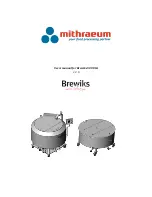
E d e l s t a h l p r o d u k t e G m b H
®
heat exchangers - hot water systems - district heating stations
German Quality / TÜV approved production
01/2013 DMS/DINOX reserves the right to make changes without notice.
9
02.3
4.2 Plumbing connections and preliminary operations
The position and function of the couplings are shown in the label attached.
It is advisable to install the appliance as close as possible to the point where most water is used, in order to
avoid heat loss along the pipes. It should also be close to a drain for convenience when emptying it.
A safety valve must be installed in the cold water pipe upstream of the heat exchanger.
It must not be possible to shut off the pipe connecting the heat exchanger and the safety valve as this would
damage the heat exchanger due to overpressure.
Take care when installing the safety valve. Do not force or tamper with it. The safety valve a rated setting
of 6 bar. Slight dripping from the safety valve is normal during heating, so it is advisable to connect it to a
trapped drain. If the mains pressure is close to the valve setting, install a suitable pressure reducer as far
away from the water heater as possible.
If the system has a pressure reducer and/or a non-return valve, it is mandatory to
install an expansion vessel the capacity of which is not less than 5% of the rated
capacity of each heating element.
Non-return valves must not be installed between the safety valve and the expansion vessel.
In general, in order to protect the appliance and the system, it is always advisable to install an expansion
vessel as specified above.
Inflate the diaphragm chamber of the expansion vessel as instructed by manufacturer.
Before connecting the appliance to the mains, fill it with water as follows:
•
turn on the cold water tap:
• turn on a hot water tap (e.g. bath, sink, etc.), bleed air from the system and wait for a constant flow
of water from all the water
taps;
•
check all the plumbing connections for leaks.
When the local water is hard, it is advisable to install specific devices to prevent excessive scale build-up.
Please note that some of them are similar to non-return valves, which means that a suitable expansion
vessel must be provided.
The appliance can have a recirculation pipe connected to it. If this is done, the pipe must be insulated.
For recirculation it is necessary to install a pump fitted with a timer or a minimum contact thermostat to acti
-
vate cooling of the recirculation water. If the coupling is not used, a seal cap must be provided.
The inlet and outlet pipes must be connected at the established points of the heat exchanger.
• Check that the thermal output of the heat generator is at least 15% higher than the thermal input of
the water heater.
• If there are any impurities in the mains water, provide a suitable filter and check that the circulation
pumps have a sufficient flow rate and pressure head and work efficiently.
•
Make sure the thermostat and thermometer probes are positioned correctly.
•
Check that the thermostat controls operate correctly.
The plumbing system must be connected as shown in the label attached.










































